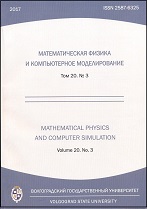|
Physics and astronomy
Determination of electron affinity on the base of experimentally measured lifetime of negative molecular ions of coumarin derivatives
M. M. Tayupov, R. G. Rakhmeev, N. L. Asfandiarov, S. A. Pshenichnyuk
Ufa Federal Research Centre of the Russian Academy of Sciences
Abstract:
Resonance attachment of low-energy (0–15 eV) electrons to molecules of 4.7- and 6.7-dihydroxycoumarin has been investigated by means of negative ion mass spectrometry. These natural compounds possess biological activity associated with antioxidant and bactericidal properties. The most probable structures of fragment negative ions ($\mathrm{[M\!-\!H]}^-$, $\mathrm{[M\!-\!2H]}^-$, $\mathrm{[M\!-\!CO]}^-$, $\mathrm{[M\!-\!COH]}^-$, $\mathrm{[M\!-\!COOH]}^-$, etc.) have been predicted by means of analysis of decay channels for molecular negative ions using the results of the density functional theory calculations. Mean lifetime for molecular negative ions of 4.7-dihydroxycoumarin relative to electron autodetachment has been measured. The adiabatic electron affinity ($EAa$) has been estimated in the framework of the Arrhenius approximation. It has been found that $EAa$ values calculated at B3LYP/6-31+G(d) level with minimal addition of diffuse functions as a difference between the total energies of a neutral molecule and its radical anion correlate with experimental $EAa$ values.
Keywords:
negative ion mass spectrometry, resonance electron attachment, quantum chemical calculations, coumarins, organic electronics.
Received: 19.05.2020
Citation:
M. M. Tayupov, R. G. Rakhmeev, N. L. Asfandiarov, S. A. Pshenichnyuk, “Determination of electron affinity on the base of experimentally measured lifetime of negative molecular ions of coumarin derivatives”, Mathematical Physics and Computer Simulation, 23:3 (2020), 45–59
Linking options:
https://www.mathnet.ru/eng/vvgum288 https://www.mathnet.ru/eng/vvgum/v23/i3/p45
|

| Statistics & downloads: |
| Abstract page: | 74 | | Full-text PDF : | 178 |
|




 Contact us:
Contact us: Terms of Use
Terms of Use
 Registration to the website
Registration to the website Logotypes
Logotypes








 Citation in format
Citation in format 